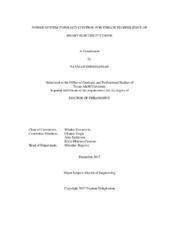| dc.description.abstract | Disruptive events, whether they are malicious attacks, natural disasters, or human-caused accidents, continually pose a risk to the acceptable electricity grid operations, and lessons learned from some recent catastrophic events have pushed the focus on the concept of “resilience”. It is becoming more and more apparent that further considerations beyond the classical reliability-oriented view are needed for enhancing the electricity grid survivability in the face of High Impact Low Probability (HILP) emergencies to keep the lights on at all times. This observation is verified by several major electricity grid outages. From 1980 to 2014, a total of 178 weather/climate caused blackouts occurred in the United States alone (8 of which occurred in 2014) with the overall damages/costs reaching or exceeding US$ 1 trillion. Both the frequency and intensity of such wide area outage events have been trending higher in recent years. With increasing dependence on electricity for most daily activities and vital services (e.g., transportation, commerce, communications, health care, etc.), an urgent need to enhance the resilience of the electricity delivery infrastructure to reduce the impact and risk from natural and human-triggered events is well recognized.
In line with the constant national push to operate the electricity grid in a smarter way by introducing advanced technologies and control mechanisms into grid operations, this dissertation tries to introduce effective decision making support tools to achieve improved efficiency and resilience by a smarter use of the grid existing infrastructure. The proposed tools are focused on the network topology control through transmission line switching actions and are taking into account several practical considerations that are essential for a successful implementation of this technology in real world scenarios. This dissertation strives to examine harnessing of the transmission assets, in both normal and emergency operating states and under various uncertainty scenarios arisen from the stochastic renewable patterns and load profiles, to reach the improved grid efficiency and resiliency goals. Such considerations, which are employed in the grid operational time frame, make it possible to reach more resilient and efficient use of existing electricity network facilities with minimal additional cost. | en |


